Data Access Feys 2024
Lower respiratory tract single-cell RNA sequencing and neutrophil extracellular trap profiling of COVID-19-associated pulmonary aspergillosis: a single centre, retrospective, observational study

COVID-19-associated pulmonary aspergillosis (CAPA) is a severe superinfection with the fungus Aspergillus affecting patients who are critically ill with COVID-19. We characterized the immune cell landscape of the lumen of the lower respiratory tract of patients mechanically ventilated because of COVID-19, comparing patients with versus without aspergillosis, using single-cell RNA sequencing on bronchoalveolar lavage samples. Patients with CAPA had significantly lower neutrophil fractions than patients with COVID-19 only. The remaining neutrophils in patients with CAPA preferentially followed a hybrid maturation trajectory characterized by expression of genes linked to antigen presentation, with enhanced transcription of antifungal effector pathways. Patients with CAPA also showed depletion of mucosal-associated invariant T-cells, reduced T helper 1 and T helper 17 differentiation, and transcriptional defects in specific aspects of antifungal immunity in macrophages and monocytes. In a partially separate cohort, we showed that levels of neutrophil extracellular traps (NETs) are significantly higher in CAPA patients compared to patients with COVID-19 only, which may explain the lower observed neutrophil fractions in the former patient group. Importantly, higher NET levels were associated with increased 90-day survival in patients with CAPA specifically.
Lower respiratory tract single-cell RNA sequencing and neutrophil extracellular trap profiling of COVID-19-associated pulmonary aspergillosis: a single centre, retrospective, observational study. Feys et al. – 2024 – The Lancet Microbe
Data Availability
Raw sequencing reads of the scRNA-seq experiments generated for this study are deposited in the EGA European Genome-Phenome Archive database under EGAD00001011342 and will be released under controlled access upon publication. Data requests will be reviewed by the UZLeuven-VIB data access committee and data can be released upon the signing of a Data Transfer Agreement. Alternatively, the filtered count matrix and basic metadata required to replicate the analysis described in the paper are freely available on this website. Please note that sample and patient identifiers have been anonymized and shuffled in these data releases and may not match those described in the paper or the supplement.
Data of the NET analyses can be shared upon reasonable request. Publicly available datasets used in this manuscript are available from EGAS00001004717, GEO GSE145926, and GEO GSE122960, and from ArrayExpress E-MTAB-6149/E-MTAB-6653.
